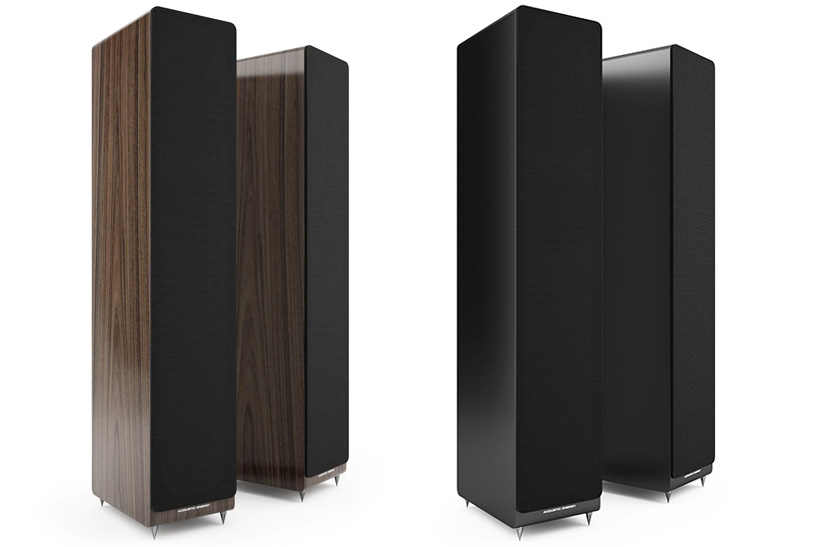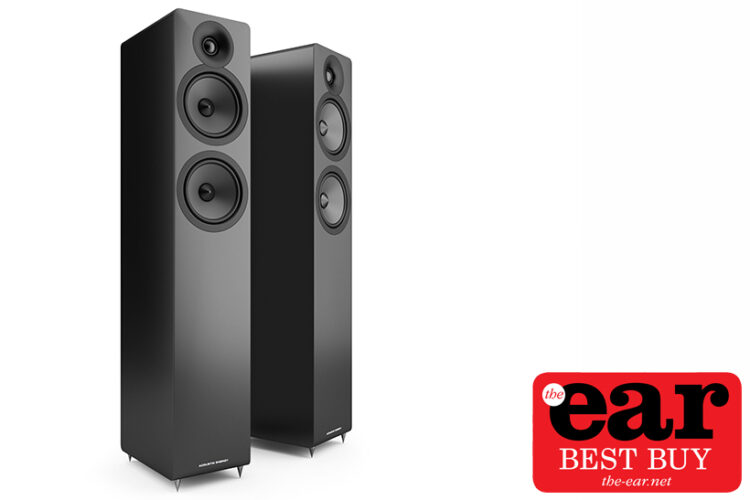Having enjoyed other models from Acoustic Energy, I was excited when a brand-new loudspeaker arrived in the shape of the slimline AE109.2 floorstander; yes – that’s a ‘2’ suggesting an upgrade to the previous 109 model although, as we shall see, the new variant is more than just a cosmetic tweak, it’s pretty much a makeover for this entry-level floorstander whose origins go back to 1996 before the company returned to British ownership.
During its five-year run, the last AE109 was very well received by the trade, reviewers and customers. But loudspeaker designers never sit still and the team down at Acoustic Energy in the Cotswolds decided it was time to shake up the budget end of the loudspeaker market, with the intention of raising the bar even higher in the face of the stiffening competition. The new 100 Series ended up being a complete rework from the ground up. The design brief was to try and maintain the compact dimensions and sleek appearance of the previous models but offer a more mature, refined and bigger sound with greater bandwidth and power.
Design
First in line for an upgrade was the main drive unit; the 4-inch paper cone used for over a decade performed admirably but AE came to conclusion that they’d extracted all the performance they could from it. So, the decision was made to move up to a 5-inch (130mm) doped-paper cone with a four-layer voice coil with flux rings to benefit dynamics, headroom and clarity.

This move necessitated the cabinet dimensions be amended to accommodate the new drivers which required greater internal volume for maximum benefit. There was therefore a move away from standard medium-density fibre board to high-density, something very unusual at this end of the market and more often found on high-end cabinets. HDF provides the option of using thinner cabinet walls but without a loss in acoustic performance; the mass and stiffness of the 15mm HDF being the same as the previous 18mm MDF. Thus, AE achieved a 30% increase in internal volume over its previous 100 Series from just a small, 15% increase in cabinet size. Genius.
To complement the mid/bass drivers a new, 25mm soft-dome tweeter (with high-power neodymium motor) and waveguide was developed for improved dispersion and, by using an arrangement from its 500 Series, they are sited as close together as physically possible, thanks to a cutaway trim. While they were at it, the designers improved veneers (black or walnut) and added a flared trim to the bass port while fitting higher-grade binding posts. To the rear of the cabinet is a slot port, an increasingly popular feature as it reduces chuffing and distortion compared to conventional, circular reflex ports while reducing room effects. In the 2.5-way crossover careful attention has been paid to phase and time alignment.
Sound quality
Unboxing and installation was straightforward although, at first, I did not install the enclosed spiked feet. This proved to be a mistake since I became aware of a tendency towards slight nasality in voice which far less noticeable on music. I also had an early issue with dialogue being somewhat recessed in some TV dramas and occurrence of actors’ voices being lost in the mix.

My initial thought was, maybe there’s a bit of a dip in the response before 1kHz which could be leaving this crucial part of the band a little exposed? Then I considered cone/drive unit coloration or a potential crossover-related issue. It then dawned on me that, being floorstanders (I primarily use standmount speakers), the cabinet will be having much more of an effect than I am used to; there’s so much more of it, and I was probably hearing some low-level cabinet coloration. Those spikes that I’d ignored were a vital part of the set-up. Bingo. Spikes fitted and issue resolved; I also took the opportunity to angle the cabinet in, ever so slightly: this lifted the 5kHz presence region and brought dialogue to the fore. This just goes to show how important set up is to achieve the ‘right’ sound, and that placement will be very room-dependent.
With the AE109.2s providing an easy load for my Hegel H190 streamer/DAC/integrated amp (for Apple Music and satellite decoder, optically-connected) I found that, while the speakers would work virtually against the rear wall, a position some 150mm away meant the front baffle was not behind my TV screen, but level with it and visually more appealing.
First-up was a track I’d heard on the radio only the day before, the house-influenced dance tune Rain on Me streamed now via Apple Lossless. While Lady Gaga and Ariana Grande attempt to out-sing each other the track did show what these entry-level speakers could achieve when it came to mastering dynamics. Wow, that cascade of piano house, disco strings, French Touch bass lines and wind-whipped EQ effects were very adeptly handled by the AE109.2 which quickly revealed a flair for timing. Those thumping basslines, pumping rhythms and speed of attack to wake the dead came through loud and clear before the rather beautiful storm of vocal ad-libs and churning sound at the end. This is the kind of complex mix that would unnerve many a loudspeaker, and many costing considerably more than those on test here. Yet the ‘109s seemed to be in their element and gave a rendition as much as to say: “Hey, listen – this is what we’re here for.” I was delighted that so much low-frequency energy could emerge from such a slimline cabinet, and in such a controlled manner.

Switching to some off-air material, courtesy of BBC Radio 2 where Blur’s Girls and Boys again revealed the speakers’ penchant for coping with LF energy in such an entertaining way. Clearly the new AE109.2 has been well designed and engineered. This was a thought conferred by Sly and the Family Stone’s Dance to the Music, an analogue production with such a musically entertaining sound via these floorstanders. Their abilities when it comes to pace and rhythm are remarkable for the price. Also, it’s good to know that against the rear wall placement is not needed for this design to create oodles of decent bass but without tending to boom, as can so often be the case at this level.
Onto more familiar territory for me and an Afternoon Concert relayed by BBC Radio 3 which featured the Pau Casals Festival Orchestra, celebrating their centenary, and treating us to Dvorak’s Sixth in D, Op. 60. The soundstage was far larger than the narrow-fronted cabinets might have created, it also had decent height and good depth. I was drawn into the presentation in a most involving and entertaining way. Treble was nicely detailed with a well dovetailed midrange which was both clear and fast, proving that the crossover is doing its job well.
Later in the day I enjoyed a performance of Beethoven’s Cello Sonata No 5 in D, Op. 1-2 with pianist Fiachra Garvey and, am very happy to report, that the piano sounded like, well, a piano. But this is not something to be taken for granted since many a loudspeaker fails miserably in recreating the sound of acoustic instruments with any degree of accuracy as some designers seem to feel the need to impose their own sound, rather than let the listener wallow in that created by the performers and studio engineer, as was happily the case here. More piano delights followed later in the week, courtesy of Haydn’s ‘Gypsy Rondo’, his Trio in G Major – with the sheer speed and agility being handled with aplomb by the AE109.2.

Finally, to an evening by the Radio France Philharmonic under Mikko Franck and Liszt’s Hungarian Rhapsody No. 6 in D flat – proving that the piano can be a percussive instrument, at the hands of the talented János Balázs and a fiendishly technical display which was brought home with such realism in a natural and wholly-believable presentation through these speakers.
Conclusion
I lived with the AE 109.2s for several weeks as my everyday speakers. Many models do not last nearly this long in my listening room, so this in itself is an accolade. So long as the price doesn’t double when Acoustic Energy read this, I think we have here the ‘bargain of the moment’ when it comes to accomplished loudspeakers; certainly, at entry-level, but almost at any level. The 109.2s really are that good. Not only is this a design that sounds very musical, they are also speakers that keep you listening to the music, and that’s probably the key for any design.
Every time I enjoy an Acoustic Energy product my mind goes back to the 1980s and my Hi-Fi News days when, I have to be honest, I did not care for the then metal drive unit affairs created under the AE marque. Goodness, what a lot has changed and all for the good to my mind. If this isn’t a Best Buy product, then I don’t know what is.


